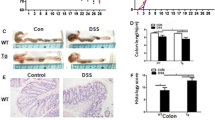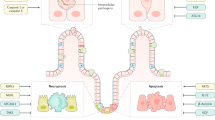Abstract
Background and aims
Inflammatory bowel diseases (IBD) evoke a damage-repair process accompanied by the activation of apoptotic genes. Data on transglutaminase (TG) expression in apoptotic cells in inflamed colonic epithelium has not been reported, although TG cross-links proteins within typical apoptotic bodies in various cell lines. In an experimental model of colitis we investigated the expression of different markers of apoptosis related to the degree and development of colonic inflammation.
Methods
Two studies were performed: (a) Colitis was induced by the administration of 2,4,6-trinitrobenzen sulfonic acid (TNBS) at a dose of 10 or 20 mg per rat in 50% ethanol, and the rats were killed 1 week later; (b) Colitis was induced by 20 mg TNBS and the rats were killed 3 days, 1, 2, and 4 weeks thereafter. The colon of rats was macroscopically assessed, and biopsies were histologically assessed and immunoprobed for FasL, FasR, p53 and tTG. Cell death was detected by TUNEL, and TG activity was assayed on colon homogenates.
Results
Study A: According to enhanced TUNEL positivity, FasR/FasL and p53 expression increased depending on the severity of the colitis. Study B showed increased p53 expression at day 3 while FasR/FasL coexpression peaked at 1 week. In both studies tTG was mainly expressed in the extracellular matrix of damaged tissue and in the submucosa.
Conclusions
Our findings suggest that expression of apoptosis markers is related to the degree of colitis and show that apoptosis is sustained by both p53 and FasR/FasL pathways, depending on the phase of colitis development. Moreover, the lack of TG staining in typical apoptotic bodies may account for a perturbation of the cross-linked apoptotic envelope that may be an important determinant in the development of immune response in ulcerative colitis.





Similar content being viewed by others
References
Thompson CB (1995) Apoptosis in pathogenesis and treatment of disease. Science 267:1456–1462
Cummings MC, Winterford CM, Walker NI (1997) Apoptosis. Am J Surg Pathol 21:88–101
Watson AJM (1995) Necrosis and apoptosis in the gastrointestinal tract. Gut 37:165–167
Que FG, Gores GJ (1996) Cell death by apoptosis: basic concepts and disease relevance for the gastroenterologist. Gastroenterology 110:1238–1243
Taylor CT, Dzus AL, Colgan SP (1998) Autocrine regulation of epithelial permeability by hypoxia: role for polarized release of tumor necrosis factor α. Gastroenterology 114:657–668
Schmitz H, Barmeyer C, Fromm M, Runkel N, Foss HD, Bentzel CJ, et al (1999) Altered tight junction structure contributes to the impaired epithelial barrier function in ulcerative colitis. Gastroenterology 116:301–309
Hond ED, Hiele M, Evenepoel P, Peeters M, Ghoos Y, Rutgeerts P (1998) In vivo butyrate metabolism and colonic permeability in extensive ulcerative colitis. Gastroenterology 115:584–590
Strater J, Wellish I, Riedl S, Walczak H, Koretz K, Tandara A, et al (1997) CD95 (APO-1/Fas) mediated apoptosis in colon epithelial cells: a possible role in ulcerative colitis. Gastroenterology 113:160–167
Ueyama H, Kiyohara T, Sawada N, Isozaki K, Kitamura S, Kondo S, et al (1998) High Fas ligand expression on lymphocytes in lesion of ulcerative colitis. Gut 43:48–55
Yonehara S, Ishii A, Yonehara MA (1989) Cell-killing monoclonal antibody (anti-Fas) to a cell surface antigen co-downregulated with the receptor of tumor necrosis factor. J Exp Med 169:1747–1756
Itoh H, Yonehara S, Ishii A, Yonehara M, Mizushima S, Sameshima M, et al (1991) The polypeptide encoded by the cDNA for human cell surface antigen Fas can mediate apoptosis. Cell 66:233–243
Nagata S, Golstein P (1995) The Fas death factor. Science 267:1449–1456
Suda T, Takahashi T, Golstein P, Nagata S (1993) Molecular cloning and expression of the Fas ligand: a novel member of the tumor necrosis factor family. Cell 75:1169–1178
Suda T, OkazakiT, Naito Y, Yojota T, Arai N, Ozaki S, et al (1995) Expression of the Fas ligand in cells of T cell leneage. J Immunol 154:3806–3813
Arase H, Arase N, Saito T (1995) Fas-mediated cytotoxicity by freshly isolated natural killer cells. J Exp Med 181:1235–1238
Leithauser F, Dhein J, Mechtersheimer G, Koretz K, Bruderlein S, Henne C, et al (1993) Constitutive and induced expression of APO-1, a new member of the nerve growth factor/tumor necrosis factor receptor superfamily, in normal and neoplastic cells. Lab Invest 69:415–429
Moller P, Koretz K, Leithauser F, Bruderlein S, Henne C, Quentmeier A, et al (1994) Expression of APO-1 (CD95), a member of the NGF-TNF receptor superfamily, in normal and neoplastic colon epithelium. Int J Cancer 57:371–377
Bennett MW, O’Connell J, O’Sullivan GC, Collins JK, Shanahan F (1998) Altered expression of Fas ligand by colonic epithelium in Crohn’s disease and ulcerative colitis. Gastroenterology 114:A929
Messmer UK, Ankarkrona N, Nicotera P, Brune B (1994) p53expression in nitric oxide-induced apoptosis. FEBS Lett 355:23–26
Miyashita T, Krajewski S, Krajewska M, Wang HG, Lin HK, Liebermann DA, Hoffman B, Reed JC (1994) Tumor suppressor p53 is a regulator of bcl-2 and bax gene expression in vitro and in vivo. Oncogene 9:1799–1805
Krishna M, Woda B, Savas L, Baker S, Banner B (1995) Expression of p53 antigen in inflamed and regenerated mucosa in ulcerative colitis and Crohn’s disease. Modern Pathol 8:654–657
Kroemer G (1997) The proto-oncogene Bcl-2 and its role in regulating apoptosis. Nat Med 3:614–620
Melino G, Piacentini M (1998) “Tissue” transglutaminase in cell death: a down stream or a multifunctional upstream effector? FEBS Lett 430:59–63
Piacentini M, Farrace MG, Hassan C, Serafini B, Autuori F (1999) “Tissue” transglutaminase release from apoptotic cells into extracellular matrix during human liver fibrogenesis. J Pathol 189:92–98
Morris GP, Beck PL, Herridge MS, Depew WT, Szewczuk MR, Wallace JL (1989) Hapten-induced model of chronic inflammation and ulceration in the rat colon. Gastroenterology 96:795–803
D’Argenio G, Sorrentini I, Cosenza V, Gatto A, Iovino P, D’Armiento EP, et al (1992) Serum and tissue transglutaminase correlates with the severity of inflammation in induced colitis in the rat. Scand J Gastroenterol 27:111–114
Lorand L, Campbell-Wilkes LK, Cooperstein L (1972) A filter paper assay for transamidating enzymes using radioactive amine substrates. Anal Biochem 50:623–631
D’Argenio G, Cosenza V, Sorrentini I, De Ritis F, Gatto A, Delle Cave M, et al (1994) Butyrate, mesalamine, and factor XIII in experimental colitis in the rat: effects on transglutaminase activity. Gastroenterology 106:399–404
Gavrieli Y, Sherman Y, Shmuel A. Ben Sasson (1992) Identification of programmed cell death in situ via specific labeling of nuclear DNA fragmantation. J Cell Biol 119:493–501
Piacentini M, Fesus L, Farrace MG, Ghibelli L, Piredda L, Melino G (1991) The expression of tissue transglutaminase in two human cancer cell lines is related with the programmed cell death (apoptosis). Eur Cell Biol 54:246–254
Lowin Bhahne M, Mattman C, et al (1994) Cytolytic T-cell cytotoxicity is mediated through perforin and Fas lytic pathways. Nature 370:650–652
Laster SM, Wood JD; Gooding LR (1988) Tumor necrosis factor can induce both apoptosic and necrotic forms of cells. J Immunol 141:221–227
Vetuschi A, Latella G, Sferra R, Caprilli R, Gaudio E (2002) Increased proliferation and apoptosis of colonic epithelial cells in dextran sulfate sodium-induced colitis in rats. Dig Dis Sci 47:1447–1457
Middleton SJ, Shorthouse M, Hunter JO (1993) Increased nitric oxide synthesis in ulcerative colitis. Lancet 341:465–466
Lundberg JON, Hellstrom PM, Lundberg JM (1994) Greatly increased luminal nitric oxide in ulcerative colitis. Lancet 344:1673–1674
Loguercio C, D’Argenio G, Delle Cave M, Cosenza V, Della Valle N, Mazzacca G, et al (1996) Direct evidence of oxidative damage in acute and chronic phases of experimental colitis. Dig Dis Sci 41:1204–1211
Wink DA, Kasprzac KS, Maragos CM (1991) DANN-deaminating ability and genotoxicity of nitric oxide and its progenitors. Science 254:1001–1003
Nguyen T, Brunson D, Crespi CL (1992) DNA damage and mutation in human cells exposed to nitric oxide in vitro. Proc Natl Acad Sci USA 89:3030–3034
Piacentini M, Autuori F, Dini L (1991) Tissue transglutaminase is specifically expressed in neonatal rat liver cells undergoing apoptosis upon epidermal growth factor-stimulation. Cell Tissue Res 263:227–235
Folk JE (1980) Transglutaminases. Annu Rev Biochem 49:517–531
Oliviero S, Amendola A, Di Sano F (1997) Tissue transglutaminase-dependent post-translational modification of the retinoblastoma gene product in promonocytic cells undergoing apoptosis. Mol Cell Biol 17:6040–6048
Fesus L, Davies PJA, Piacentini M (1991) Apoptosis: molecular mechanism of programmed cell death. Eur J Cell Biol 56:170–177
Fesus L, Thomazy V, Autuori F, Cerù MP, Tarcsa E, Piacentini M (1989) Apoptotic hepatocytes become insoluble in detergents and chaotrophic agents as a result of transglutaminase action. FEBS Lett 245:150–154
Savill J, Fadok V, Henson Phaslett C (1993) Phagocyte recognition of cells undergoing apoptosis. Immunol Today 14:131–136
Arends MJ, Wjllie AH (1991) Apoptosis. Mechanism and role in pathology. Int Rev Exp Pathol 32:223–254
D’Argenio G, Biancone L, Cosenza V, Della Valle N, D’Armiento FP, Boirivant M, et al (1995) Transglutaminases in Crohn’s disease. Gut 37:690–695
D’Argenio G, Cosenza V, Riegler G, Della Valle N, De Ritis F, Mazzacca G, Gruppo Italiano per lo Studio del Colon e retto (GISC) (2001) Serum transglutaminase correlates with endoscopic and histopathologic grading in patients with ulcerative colitis. Dig Dis Sci 46:649–657
D’Argenio G, Grossman A, Cosenza V, Della Valle N, Mazzacca M, Bishop PD (2000) Recombinant factor XIII improves experimental colitis in rats. Dig Dis Sci 45:987–997
D’Argenio G, Iovino P, Cosenza V, Della Valle V, De Ritis F, Mazzacca G (2001) Factor XIII improves gastric stress lesions in rats. Digestion 63:220–228
Author information
Authors and Affiliations
Corresponding author
Rights and permissions
About this article
Cite this article
D’Argenio, G., Farrace, M.G., Cosenza, V. et al. Expression of apoptosis-related proteins in rat with induced colitis. Int J Colorectal Dis 19, 451–460 (2004). https://doi.org/10.1007/s00384-004-0585-5
Accepted:
Published:
Issue Date:
DOI: https://doi.org/10.1007/s00384-004-0585-5




